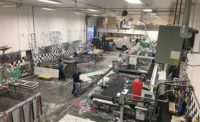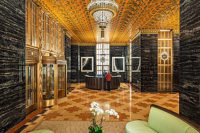Over the years, the improvements made, including limestone balustrades and urns, had deteriorated. The Friends of Rittenhouse Square took the 100th anniversary of Cret’s design as an opportunity to restore these important features to their original state, without changing the design. In July of 2013, a team of conservators and masons started restoring the park’s limestone balustrades at the four corner entrances. In addition to the masonry project, the park’s lighting was upgraded for both security and aesthetic purposes. “What we’re trying to achieve is to bring back the park to what it should look like, enhancing it slightly,” said Betsy Hummel, Friends of Rittenhouse Square president. “I don’t think people will notice a huge change, but I think they’ll notice the park really looks nice, especially at night.”
In Cret’s original design, limestone balustrades frame the interior oval and four corner entrances. The balustrades were originally built of Indiana limestone, but as time went on, sections were lost because of weathering, accidents, vandalism or general wear and tear. This led to a gap-toothed look in several areas of the park. Some of these missing pieces were replaced with cast stone, while others were gone altogether.
|
Rittenhouse Square Philadelphia, PA |
|
Project Manager and Funder: Friends of Rittenhouse Square Land Owner: Philadelphia Parks and Recreation Conservator: Materials Conservation Co. LLC, Philadelphia, PA Sub-Contractor: Knapp Masonry, Magnolia, NJ Lighting Upgrades: 521 Atelier, Bryn Mawr, PA |
“The exact problems, in addition to missing damaged balusters, and the temporary concrete cast ones, were a huge amount of graffiti on surfaces, a lot of biological growth, uric acid damage from dogs, and perhaps some other contaminants,” said Friends of Rittenhouse Square board member, Derek Freres. “All 592 balusters were loose and needed to be reset through the use of stainless steel pins on either end. All stonework needed to be repointed as well, as over the course of 100 years the pointing had broken and dropped out in many places.” The new balusters were custom made, based on the original profile from Indiana Limestone Fabricators, Inc. in Spencer, IN.
Crews from Knapp Masonry, under the guidance of Materials Conservation Co., started removing the thick limestone slabs that rest on top of the balustrades to clean, repair and reinstall original limestone pieces. “The ferrous dowels used to connect the balusters were severely corroding and damaging the limestone, resulting in a campaign to replace a significant number of the balusters with cast concrete replacements back in the 1970s,” said David Facenda, Architectural Conservator at Materials Conservation Co.
“All concrete balusters were replaced with new limestone as part of our scope. We repaired what we could salvage (cracked limestone balusters or balusters with minor loss). We replaced all missing balusters and concrete units with Indiana limestone to match the original.”
No changes were made to the previous design, except a substitution of stainless steel dowels to replace the original iron dowels. To clean the limestone, the team used a low-pressure mild-abrasive system and an architectural biocide.
The park’s southwest entrance was completed first. The team then worked their way around the perimeter entrances and later moved on to the park’s interior. In addition to the balustrade, the limestone urns were restored and the lead urns repaired.
The Friends of Rittenhouse Square also worked with the Fairmount Park Historic Preservation Trust to remove graffiti in the park — often on limestone elements that needed to be cleaned and restored. In an effort to deter tagging of the freshly cleaned or brand new limestone, surveillance cameras were installed throughout the area.
The goal was to complete the project within 12 months (with some lead time for baluster construction), a timeline that was met successfully. However, the team did face difficulties along the way. “We encountered a major graffiti problem, which required extensive removal techniques,” said Freres. “We used Kiem PSS-20 to coat the stone so that future graffiti could be more easily removed.”
The reaction to the project has been extremely positive. It won the Preservation Alliance’s award in 2014 and perhaps most importantly, the work done to preserve the park will help ensure the continued existence of these character defining features in the years to come.














